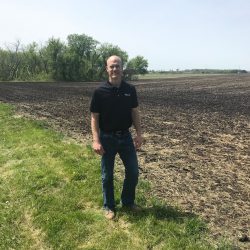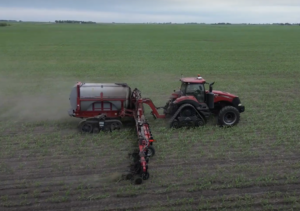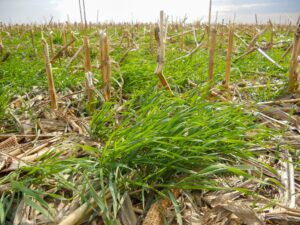By: 4R Plus
May 2020

Non-operating landowners rate conservation and stewardship as a top priority – ranking closely with ownership of land being a source of income and a desire to keep the farm in the family, according to a Hertz Farm Management, Inc., survey of its clients. Landowners recognize farms that are managed using 4R Plus practices are more productive and valuable, said Ryan Kay, a farm manager with Hertz.
“When practices that impact nutrients, soil health and soil erosion are implemented properly, buyers take notice,” Kay said. “It’s important that permanent structures like waterways and terraces are kept up, that the health of the soil is managed and 4R nutrient management practices are used. When that’s accomplished, farmland is more productive and also more desirable to buyers.”
When Kay works with non-operating landowners, he outlines strategies to keep the farm productive for years to come and takes pride knowing conservation is one of their top priorities. With more than half of Iowa’s farmland owned by non-operating landowners, he says it’s important for tenants to keep in mind that farmland owners care how the land is managed.
“Landowners want to see erosion eliminated and for soil to be healthy to support crop development,” he said. “Knowing that conservation is important to landowners should give tenants encouragement to approach landowners with recommendations that improve the farm.”

When working with landowners, Kay evaluates the farm and explains what can be improved to maintain its long-term value. “Non-operating landowners I work with are eager to learn what can be done,” he said.
Similarly, Kay encourages tenants to use technology, like imagery from drones and yield maps, to point out opportunities to improve the farm. He also encourages tenants to be transparent. “If there’s an issue with a farm, you want to make sure you have data that supports your recommendation and how much it will cost,” he said. “Show it’s a win-win and provide one or more strategies to make sure the improvements you suggest are done right.”
When implementing a practice like no-till or cover crops, Kay says tenants need to make sure they present information to landowners to support claims they are making about the benefits of the practice. For example, claims that the practice will eliminate erosion and improve soil health while also having a positive impact on yields. “It helps if a tenant provides in-field data from one of their personal fields to back up the recommendation,” he said.
Practices like cover crops can also be incorporated into the lease, but Kay warns it must be added for the right reason. “The most important thing is that everyone has the same end goal and knows the reason why a practice is being added,” he said. “I’ve seen it where the landowner pays for the seed and the tenant pays for the application. We’ve done it where the rent is reduced to offset some of the cost. It depends on the goal of the tenant and the landowner.”
For that reason, Kay uses a team mentality when he communicates with landowners. “I think it’s important to remember the landowner and the tenant are a team – to have all hands on deck when you’re working to improve a farm,” he said. “Make sure the right practices are in place to keep the soil from moving and to improve the quality of the water.”
Landowners take pride passing the land through the generations, Kay added. “Just like you want to take care of your personal health, well-cared for farmland requires a long-term investment to stay productive,” he said.



